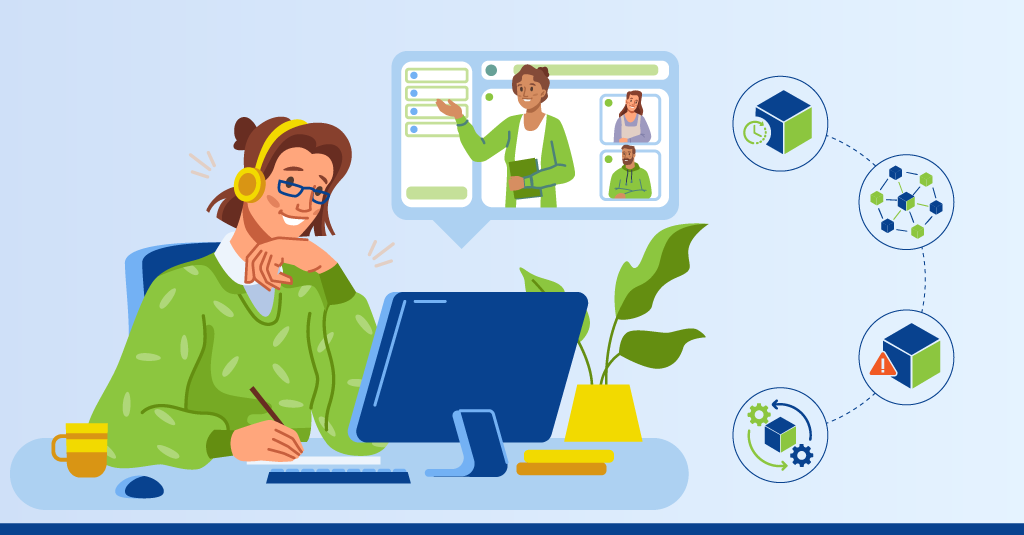Episode 3 – Amit Garg speaks with Lori Spahr
Welcome to this third edition of the Microlearning Thoughts, where we are speaking with Learning leaders as part of our Go Beyond campaign on Microlearning.
In this third conversation of the series, I chatted with Lorie Spahr from Sierra wireless to know what is her approach towards creating microlearning and how they are implementing it for their learners. Read the insightful conversation below:
Amit: Welcome everyone to episode 3 of the podcast Microlearning Thoughts, I am Amit Garg CEO and Founder of Upside Learning, we will be talking to Lori Spahr, Program Manager, and Instructional Designer at Sierra Wireless.
Welcome, Lori to this Podcast!
Lori: Thanks Amit for inviting me to this Podcast, looking forward to having an exciting discussion with you
Amit: Great, To start with I would like to know how do you define Microlearning?
Lori: Well, Microlearning for me is a short (1-5 minutes) instruction focused on one topic. Microlearning can be conveyed via different modalities – video, podcast, eLearning, email.
Amit: That’s a sharp definition, I like it. And the use of email as a modality for microlearning is interesting too.
Amit: what makes Microlearning so attractive to your area of work? Where does it fit in your overall strategy?
Lori: Our business is in a constant state of change, so microlearning continues to be a strategic avenue for our training and enablement team. It can be developed quickly, SMEs can review quickly, it has a low development cost, and it can be easily added to a more robust curriculum of content that is more static. Our sales team can digest the microlearning without feeling like they are losing selling time and can reflect on that single piece of learning to help reinforce the learning.
Amit: Great points Lori. I particularly like the point about being able to add them to a robust but static curriculum. I assume it helps in extending the curriculums and space it out a bit. Has that delivered some benefits for you?
Lori: To be honest we have just started this strategy as a way to adapt to the ever-changing business and do more with the same number of resources.
Amit: Also do you have some stand-alone microlearning too which is not being added to a curriculum? If yes, how do you go about identifying the need for such microlearning?
Lori: Well, yes, kind of. Let me give you an example. We recently had a big launch of a 5G product. The concepts of 5G are new, evolving, and can be difficult to understand for both our internal people and our customers. There are some very important concepts that our customers need to know in order to make the right decision based on their deployment area, use case, timeline, and carrier. To support both our product and general 5G concepts, we created microlearning in the form of video snippets and emails (the emails were 300 words or less and were supported with graphic content). Some of these video snippets were distributed to our channel and some posted on our website. Some were even co-branded and distributed through a partner. So for our internal learners, microlearning was part of a larger curriculum, but for the outside world, they stand alone.
Amit: Excellent. That makes perfect sense.
Amit: What have you learnt over the last few years while implementing Microlearning for your teams?
Lori: Microlearning can be conveyed via different modalities – video, podcast, eLearning, email.
Amit: Indeed. In fact, even non-digital options like the good old printed checklists too are available.
Amit: Additionally it will be great to learn of any specific challenges you faced in microlearning development and/or delivery and how you overcome those. Anything you can share on that?
Lori: This isn’t just for microlearning, but for all learning, getting SME time is always our biggest hurdle. We have found by aligning an efficient learning strategy across many of our SMEs we can create a better sense of collaboration. The SME’s workload is reduced by participating in the learning strategy, the SMEs feel supported by the collaboration, morale of those involved increases, and the learners appreciate a shorter, more effective learning experience. This hasn’t happened across the board, but we are making slow progress!
Amit: That’s great to know, thanks for sharing.
Amit: What tools & tech do you rely on to get Microlearning developed and delivered to your audience?
Lori: Usually Storyline or Rise and Adobe products like After Effects, Premiere Pro, or Audition.
Amit: Those are all great tools. We’ve also found organizations using even MS Word and PPT for creating PDF or animated outputs. These help in bringing SMEs on board to create some microlearning themselves as the tools themselves are quite common and need no additional skills. Are you involving SMEs to create some of the microlearning at Sierra? If yes, how?
Lori: Yes! In fact, Upside has helped develop technical videos created by our technical SMEs. Our technical OEM SMEs develop videos (not quite short enough to be considered microlearning, but they do focus on one topic at a time) and you have been adding an intro, outro, OST, and VO to create professional tutorials for our distributors.
Amit: Thank you for mentioning that. We’ve always enjoyed working with your teams
Amit: How do you measure the success of your Microlearning initiatives?
Lori: Great question that I don’t have a solid answer for. Sometimes we attach a “smile sheet” survey to gauge whether or not learners are receptive to the learning.
Amit: You’re right ‘smile sheets’ help us gauge how receptive our learners are. And I’m sure you agree, there is room to do more.
Amit: Since you talked of using microlearning for the sales team, I can think of one of our clients who correlates the training data with sales data at aggregate and granular levels. They have been able to show a positive correlation over an extended period of time, which is quite neat as the next stage of measurement, I think. What do you think about it?
Lori: We have loosely correlated sales data with training. We have been able to use short-term initiatives to correlate effectiveness but because of the short-term nature, we usually use informational webinars which consist of very little training.
Amit: What advice would you give to fellow L&D, OR, HR teams just starting on their Microlearning journey?
Lori: Keep it short, sweet, and to the point. Research best practices. Research creative ideas.
Amit: Absolutely, One thing that microlearning does need is to keep it short. As short as possible. Any best practices that you can share with our listeners?
Lori: Remember that microlearning can come in many different forms with varying levels of development. I have created microlearning that takes a long time to develop because of the intensity of graphic animation, production, and refinement of the content. But like you mentioned above, microlearning can also take the form of a document or a short video with a smartphone. I think sometimes those of us that develop eLearning have a hard time letting go of the “quality” level and development time we usually associate with eLearning. An effective, engaging, timely, and relevant microlearning could easily be shot with a smartphone and an SME with a little bit of guidance (and if needed, a video editing application.
Amit: Yeah, horses for courses, right. That’s great advice, Lori. Well, with that we would wrap this up. It’s been a great conversation, very insightful.
Thank you for taking the time out for this. Really appreciate it.



















